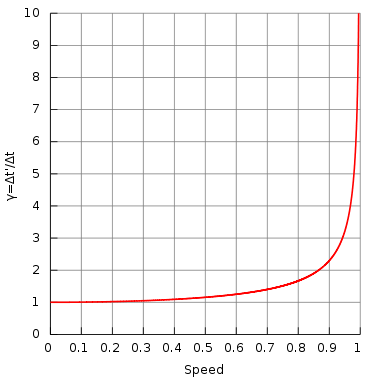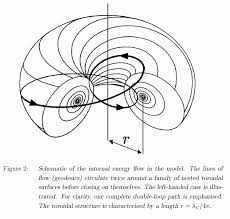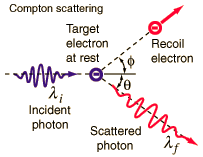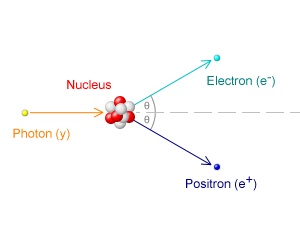hackenslash wrote:Except of coourse that, for a photon, everything does happen at once!Coito ergo sum wrote:Time is just nature's way of making sure everything doesn't happen at once.
Time Explained
- Tigger
- 1,000,000,000,000,000,000,000 piccolos
- Posts: 15714
- Joined: Thu Feb 26, 2009 4:26 pm
- About me: It's not "about" me, it's exactly me.
- Location: location location.
Re: Time Explained

Seth wrote:Fuck that, I like opening Pandora's box and shoving my tool inside it
-
Coito ergo sum
- Posts: 32040
- Joined: Wed Feb 24, 2010 2:03 pm
- Contact:
Re: Time Explained
Touche'hackenslash wrote:Except of coourse that, for a photon, everything does happen at once!Coito ergo sum wrote:Time is just nature's way of making sure everything doesn't happen at once.
Re: Time Explained
Sigh. A photon is just a photon. It gets emitted. Then It travels through space at c. Then something gets in its way, and it gets absorbed. These events don't happen all at once, despite the apparent infinite time dilation in the photon frame. Because time is an emergent property of motion, that's all. If you were travelling at c, and we all know you can't, you couldn't experience any local motion, because vector addition of this local motion plus your motion through space would result in a speed greater than c. And that can't happen because of what pair production tells us: electrons are quite literally made from light. You're made of electrons, so in the end you're made of light too. And light can't go faster than light. Simple. No local motion means no time.
- Nautilidae
- Posts: 142
- Joined: Wed Feb 24, 2010 12:10 am
- Contact:
Re: Time Explained
Why would there be infinite time dilation in the photon's frame of reference? It has no mass.Farsight wrote:Sigh. A photon is just a photon. It gets emitted. Then It travels through space at c. Then something gets in its way, and it gets absorbed. These events don't happen all at once, despite the apparent infinite time dilation in the photon frame. Because time is an emergent property of motion, that's all. If you were travelling at c, and we all know you can't, you couldn't experience any local motion, because vector addition of this local motion plus your motion through space would result in a speed greater than c. And that can't happen because of what pair production tells us: electrons are quite literally made from light. You're made of electrons, so in the end you're made of light too. And light can't go faster than light. Simple. No local motion means no time.
Re: Time Explained
It has no mass because it's travelling at c, you can't make it travel faster or slower, and it isn't at rest. Hence "rest mass" does not apply. Mass is a measure of a system's energy content, a measure of how much energy is notionally "at rest" within that system. It isn't truly at rest of course, a photon in a mirror-box adds mass to that system, and it's still moving at c. But it isn't getting out of the system, so from the outside ignoring what's going on inside, the energy is at rest. Hence the system mass is increased. The photon has no mass, but it adds mass, and regardless of mass, it's still subject to infinite time dilation. That's why "for the photon, everything happens at once".
Photons aren't people, they're just particles, they never experience anything. But let's examine something that does. You. Imagine you're accelerating across the universe in a gedanken spaceship. As you increase your speed time dilation increases:

Of course, you don't notice it locally. In your frame local clocks clock-up time just like they always did. But when you look at distant "universal clocks" such as pulsars, you notice they're going faster and faster, so you know your relative time dilation is increasing. We know you can't actually reach c, but assume you can get arbitrarily close to it. At c, this time dilation goes infinite. You don't notice anything at all because there's no motion in your local frame, hence light along with your vision and your thinking has effectively stopped. You traverse the known universe in 100 billion years, but to you it all occurs in one infinitesimal instant which escapes your notice. All of time is one infinitesimal instant. Any observations you planned on making in your frame of reference occur "beyond the end of time", and never actually take place. Your frame of reference has been time-dilated out of existence. You don't see anything. Thus you don't see the asteroid that gets in your way, bringing your non-observation to a fiery end.
Photons aren't people, they're just particles, they never experience anything. But let's examine something that does. You. Imagine you're accelerating across the universe in a gedanken spaceship. As you increase your speed time dilation increases:

Of course, you don't notice it locally. In your frame local clocks clock-up time just like they always did. But when you look at distant "universal clocks" such as pulsars, you notice they're going faster and faster, so you know your relative time dilation is increasing. We know you can't actually reach c, but assume you can get arbitrarily close to it. At c, this time dilation goes infinite. You don't notice anything at all because there's no motion in your local frame, hence light along with your vision and your thinking has effectively stopped. You traverse the known universe in 100 billion years, but to you it all occurs in one infinitesimal instant which escapes your notice. All of time is one infinitesimal instant. Any observations you planned on making in your frame of reference occur "beyond the end of time", and never actually take place. Your frame of reference has been time-dilated out of existence. You don't see anything. Thus you don't see the asteroid that gets in your way, bringing your non-observation to a fiery end.
- Nautilidae
- Posts: 142
- Joined: Wed Feb 24, 2010 12:10 am
- Contact:
Re: Time Explained
It's reversed; it's traveling at c because is has no mass.Farsight wrote:It has no mass because it's travelling at c, you can't make it travel faster or slower, and it isn't at rest.
Re: Time Explained
Come on Nautilidae, think it through, it's simple. The photon in the mirror-box is legit. Read Einstein's 1905 paper on how a body that emits radiation loses mass. Let that photon out of that mirror-box, and the system loses mass. So what happens in electron/positron annihilation? You've let two photons out of their boxes, only there's no boxes left. And the electron and the positron have angular momentum and magnetic dipole moment. Something's going round and round in there. Now what could it be? A little billiard-ball point particle? A wave of probability? No. It's just light. The electron is just a photon going round and round. That's why it has mass, because the energy/momentum isn't going anywhere. Because those photons were trapped in a box of their own making. And when you try to make an electron go somewhere at c, you can't. Because that component photon is going round and round at c, and if the electron as a whole was going at c, that photon would be tracing a helical path, at more than c. It can't happen. That's why massive bodies cannot travel at the speed of light. Because they're made of it.
- Nautilidae
- Posts: 142
- Joined: Wed Feb 24, 2010 12:10 am
- Contact:
Re: Time Explained
As Richard Feynman said, "there is no photon bag". There is already an explanation for the spin and moment of the electron. How would a photon traveling in a circular path be moving faster than the speed of light?Farsight wrote:Come on Nautilidae, think it through, it's simple. The photon in the mirror-box is legit. Read Einstein's 1905 paper on how a body that emits radiation loses mass. Let that photon out of that mirror-box, and the system loses mass. So what happens in electron/positron annihilation? You've let two photons out of their boxes, only there's no boxes left. And the electron and the positron have angular momentum and magnetic dipole moment. Something's going round and round in there. Now what could it be? A little billiard-ball point particle? A wave of probability? No. It's just light. The electron is just a photon going round and round. That's why it has mass, because the energy/momentum isn't going anywhere. Because those photons were trapped in a box of their own making. And when you try to make an electron go somewhere at c, you can't. Because that component photon is going round and round at c, and if the electron as a whole was going at c, that photon would be tracing a helical path, at more than c. It can't happen. That's why massive bodies cannot travel at the speed of light. Because they're made of it.
Re: Time Explained
I'm a Feynman fan, but there are some things he didn't get right, more's the pity. For example, the positron isn't a time-reversed electron, because things don't move through time, they move through space, and we employ regular motion to mark out time. As for the photon bag, yes, there is no bag when it comes to electron-proton bonds or say the hyperfine transition. But look to the proton. The bag model applies. And when you perform low-energy proton-antiproton annihilation, what do you get? Neutral pions, which last for a nanosecond, then decay into photons. Not quarks. Photons.
The explanation for electron spin etc is inadequate, it gives up on explanation by labelling it as intrinsic, or gives up like lpetrich did with his spinorness label. It doesn't explain how pair production converts the photon into the electron and positron, it doesn't explain what the electron is, and it doesn't explain how photons result from annihilation. Photons travel at the speed of light, whether they're going straight or not. Light doesn't move faster than light. The inference that it does is based upon the spin of a sphere, not the double spin around the moebius which accounts for the spin 1/2 and g=2.

This thing about mass really is how I described it. There really is a symmetry between momentum and inertia. All you have to do to see it is to look at Compton scattering.

The photon has no mass, just energy/momentum. It delivers a "bump" to the electron, which recoils. Now remind yourself that motion is relative, and turn things around. Imagine it's the electron moving, and now the photon doesn't deliver a bump, it is a bump, the electron bounces off it, and the momentum now looks like inertia.
There's a parallel here with an ocean wave. If you're in a boat the wave passes through and you bob up and down. Then you say it's an action, with a frequency, and E=hf because it's a wave. But pace it in a helicopter, and you don't see action, just a bump in the ocean. There is no frequency, because in this frame it isn't a wave, it's a bump, it's a particle, hence E-mc². This is the secret of wave-particle duality. Yes, you can't travel at c, but when you make the photon go round and round because it's travelling through itself, you don't have to.
The explanation for electron spin etc is inadequate, it gives up on explanation by labelling it as intrinsic, or gives up like lpetrich did with his spinorness label. It doesn't explain how pair production converts the photon into the electron and positron, it doesn't explain what the electron is, and it doesn't explain how photons result from annihilation. Photons travel at the speed of light, whether they're going straight or not. Light doesn't move faster than light. The inference that it does is based upon the spin of a sphere, not the double spin around the moebius which accounts for the spin 1/2 and g=2.

This thing about mass really is how I described it. There really is a symmetry between momentum and inertia. All you have to do to see it is to look at Compton scattering.

The photon has no mass, just energy/momentum. It delivers a "bump" to the electron, which recoils. Now remind yourself that motion is relative, and turn things around. Imagine it's the electron moving, and now the photon doesn't deliver a bump, it is a bump, the electron bounces off it, and the momentum now looks like inertia.
There's a parallel here with an ocean wave. If you're in a boat the wave passes through and you bob up and down. Then you say it's an action, with a frequency, and E=hf because it's a wave. But pace it in a helicopter, and you don't see action, just a bump in the ocean. There is no frequency, because in this frame it isn't a wave, it's a bump, it's a particle, hence E-mc². This is the secret of wave-particle duality. Yes, you can't travel at c, but when you make the photon go round and round because it's travelling through itself, you don't have to.
-
ChildInAZoo
- Posts: 257
- Joined: Sat Apr 24, 2010 4:53 pm
- Contact:
Re: Time Explained
Can you provide us with some way that a photon can a) split in two, and b) produce electric charge? I mean, I don't think I can take what you write seriously unless you can provide some way to predict that pair production can happen in some way that actually predicts the sort of particles with the right sort of properties.
Re: Time Explained
I can describe how it happens, but to do that I really need a whole new thread covering the fundamentals of electromagnetism. I can't predict it however, all I can give is postdiction to explain what we see in experiments. Have a look at Williamson's draft paper at http://www.cybsoc.org/cybcon2008prog.htm#jw for an attempt at mathematical rigor - it isn't easy. IMHO what's important first is the experimental evidence. Pair production happens, the electron really does exhibit angular momentum and spin 1/2 and magnetic dipole moment, and Stern-Gerlach fits with a real spin in two orientations. The "not classical" assertion in the wiki article really is a non-sequitur.


Re: Time Explained
That's just how fast light moves.
Re: Time Explained
Time is simply an emergent property of motion, and light moves, but if there were a universe made entirely of photons there would still be no time. Maybe photons don't move.hiyymer wrote:why c?
-
ChildInAZoo
- Posts: 257
- Joined: Sat Apr 24, 2010 4:53 pm
- Contact:
Re: Time Explained
How can you look at the experiments as evidence when you can't describe what happens in the experiments?Farsight wrote:I can describe how it happens, but to do that I really need a whole new thread covering the fundamentals of electromagnetism. I can't predict it however, all I can give is postdiction to explain what we see in experiments. Have a look at Williamson's draft paper at http://www.cybsoc.org/cybcon2008prog.htm#jw for an attempt at mathematical rigor - it isn't easy. IMHO what's important first is the experimental evidence. ]
Who is online
Users browsing this forum: No registered users and 9 guests